Global Economy: Factors Influencing M&A and India & China Analysis
VerifiedAdded on 2023/04/22
|12
|2987
|442
Essay
AI Summary
This essay provides a comprehensive analysis of the factors influencing the pace and pattern of cross-border mergers and acquisitions (M&A), with a specific focus on the economies of India and China. It explores various factors such as payment modes, deal sizes, advisor roles, and the impact of industry and firm-specific factors like liquidity ratios and prior acquisition experience. The essay also delves into country-specific factors, including political environment, economic indicators, and institutional laws, highlighting challenges in data interpretation and the importance of accurate data for effective cross-border trade. Furthermore, it compares the economic growth, GDP, GNP, health sector, and educational status of India and China, addressing the problems affecting their economies and providing insights into their development trajectories and future prospects. The essay concludes by emphasizing the critical role of both internal constraints and strategic policies in shaping the economic landscape of these two influential nations.
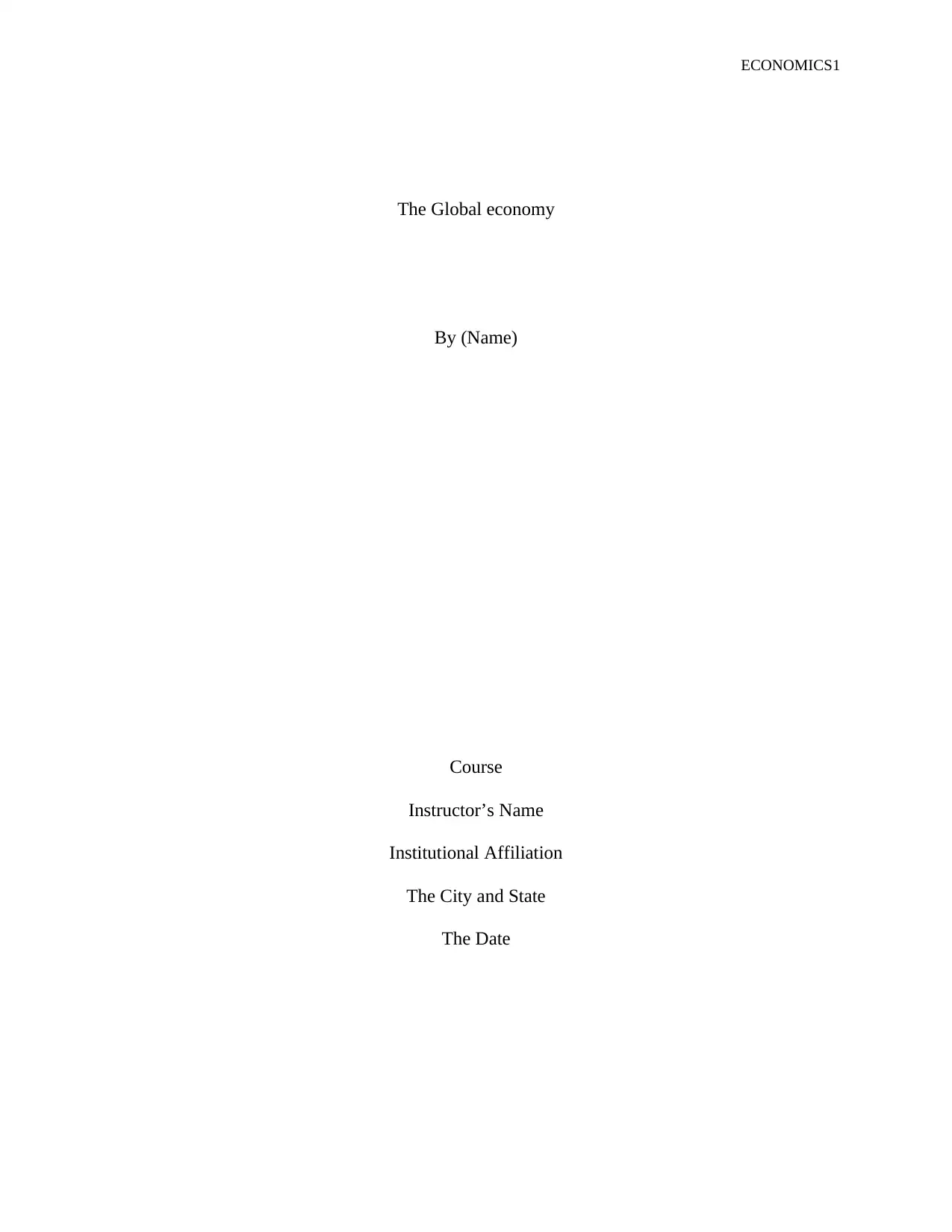
ECONOMICS1
The Global economy
By (Name)
Course
Instructor’s Name
Institutional Affiliation
The City and State
The Date
The Global economy
By (Name)
Course
Instructor’s Name
Institutional Affiliation
The City and State
The Date
Paraphrase This Document
Need a fresh take? Get an instant paraphrase of this document with our AI Paraphraser
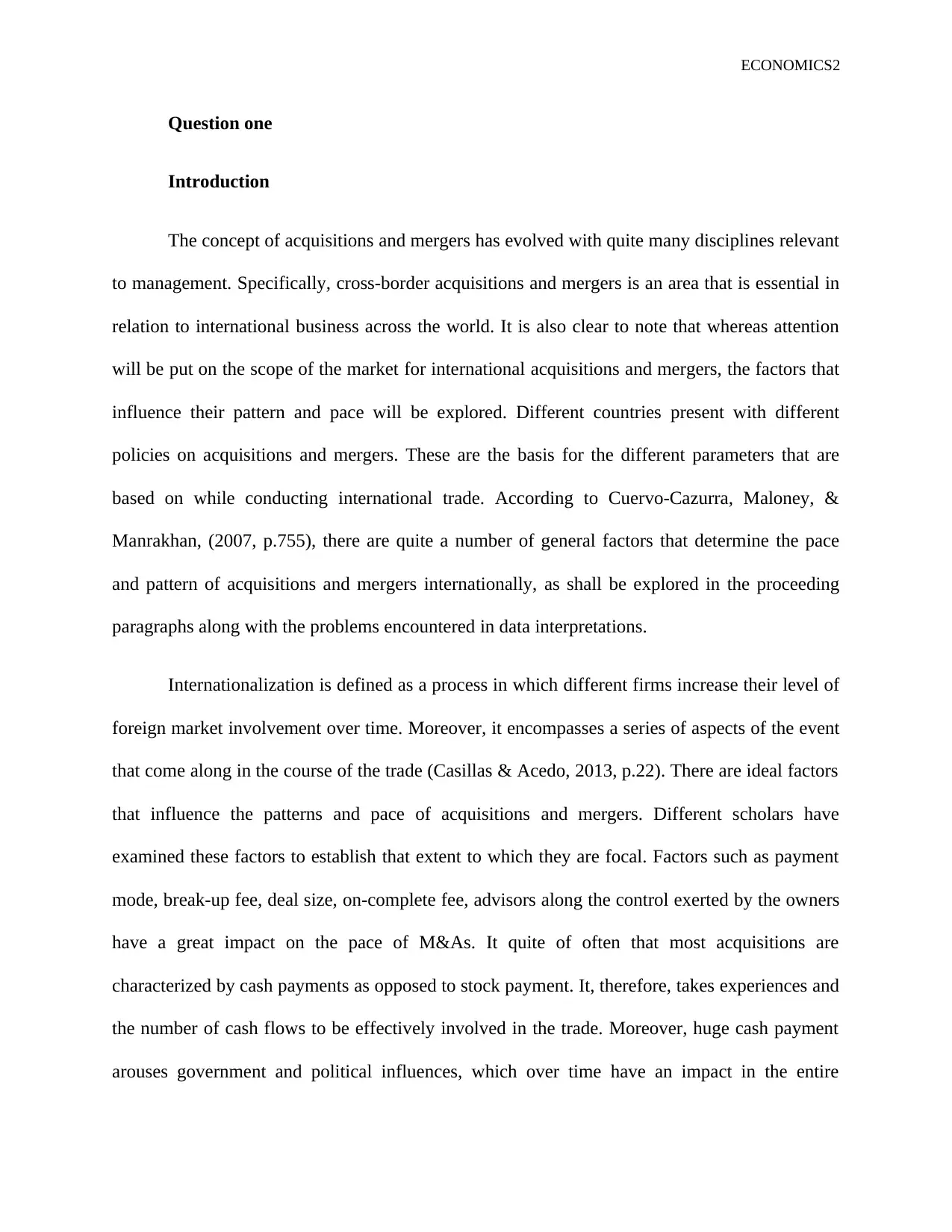
ECONOMICS2
Question one
Introduction
The concept of acquisitions and mergers has evolved with quite many disciplines relevant
to management. Specifically, cross-border acquisitions and mergers is an area that is essential in
relation to international business across the world. It is also clear to note that whereas attention
will be put on the scope of the market for international acquisitions and mergers, the factors that
influence their pattern and pace will be explored. Different countries present with different
policies on acquisitions and mergers. These are the basis for the different parameters that are
based on while conducting international trade. According to Cuervo-Cazurra, Maloney, &
Manrakhan, (2007, p.755), there are quite a number of general factors that determine the pace
and pattern of acquisitions and mergers internationally, as shall be explored in the proceeding
paragraphs along with the problems encountered in data interpretations.
Internationalization is defined as a process in which different firms increase their level of
foreign market involvement over time. Moreover, it encompasses a series of aspects of the event
that come along in the course of the trade (Casillas & Acedo, 2013, p.22). There are ideal factors
that influence the patterns and pace of acquisitions and mergers. Different scholars have
examined these factors to establish that extent to which they are focal. Factors such as payment
mode, break-up fee, deal size, on-complete fee, advisors along the control exerted by the owners
have a great impact on the pace of M&As. It quite of often that most acquisitions are
characterized by cash payments as opposed to stock payment. It, therefore, takes experiences and
the number of cash flows to be effectively involved in the trade. Moreover, huge cash payment
arouses government and political influences, which over time have an impact in the entire
Question one
Introduction
The concept of acquisitions and mergers has evolved with quite many disciplines relevant
to management. Specifically, cross-border acquisitions and mergers is an area that is essential in
relation to international business across the world. It is also clear to note that whereas attention
will be put on the scope of the market for international acquisitions and mergers, the factors that
influence their pattern and pace will be explored. Different countries present with different
policies on acquisitions and mergers. These are the basis for the different parameters that are
based on while conducting international trade. According to Cuervo-Cazurra, Maloney, &
Manrakhan, (2007, p.755), there are quite a number of general factors that determine the pace
and pattern of acquisitions and mergers internationally, as shall be explored in the proceeding
paragraphs along with the problems encountered in data interpretations.
Internationalization is defined as a process in which different firms increase their level of
foreign market involvement over time. Moreover, it encompasses a series of aspects of the event
that come along in the course of the trade (Casillas & Acedo, 2013, p.22). There are ideal factors
that influence the patterns and pace of acquisitions and mergers. Different scholars have
examined these factors to establish that extent to which they are focal. Factors such as payment
mode, break-up fee, deal size, on-complete fee, advisors along the control exerted by the owners
have a great impact on the pace of M&As. It quite of often that most acquisitions are
characterized by cash payments as opposed to stock payment. It, therefore, takes experiences and
the number of cash flows to be effectively involved in the trade. Moreover, huge cash payment
arouses government and political influences, which over time have an impact in the entire

ECONOMICS3
process of the deals being completed. It is therefore vital to ensure that local players along with
advisors in the trade of mergers and acquisitions are involved to understand the dynamics of the
trade. Advisors play a crucial role in international mergers and acquisitions for a number of valid
reasons. It is through the advisors that knowledge on the institutional framework of the host
nation can be obtained. This enables due diligence to be conducted and ensure that all the legal
proceedings are upheld.
In addition to the above factors, there are industry and firm-specific factors that affect the
pace of cross-border acquisitions and mergers. Ryan, & Stähler, (2012, p.849) asserts that the
liquidity ratio is one of the vital factors. Firms associated with a remarkable liquidity ratio
engage more in international investment. The above is explained by their ability to own huge
asserts and financial power to effectively engage in big transactions and purchase or merge with
small firms. Moreover, firms that have high levels of productivity mostly engage in FDI as
opposed to acquisition. Financial constraints, therefore, determine a firm's ability to acquire
another firm internationally or merge. It is therefore clear to note that big firms with a big market
share and financial abilities engage most in international acquisition in order to expand their
operations. Ahammad and Glaister (2013, p.899) further assert that the target size has a very
positive impact on the performance of acquisitions. Moreover, it was also noted that acquiring
companies that employ huge resources and exerting more efforts often result in the mergers and
acquisition success in the event that the size being targeted is greater. This is as opposed to small
firms that do not have the ability to trade with huge firms because of their financial constraints
and low market share in the market.
prior-acquisition and organizational learning experience is another influential factor. In
the business context, learning and experience are some of the vital aspects that determine how
process of the deals being completed. It is therefore vital to ensure that local players along with
advisors in the trade of mergers and acquisitions are involved to understand the dynamics of the
trade. Advisors play a crucial role in international mergers and acquisitions for a number of valid
reasons. It is through the advisors that knowledge on the institutional framework of the host
nation can be obtained. This enables due diligence to be conducted and ensure that all the legal
proceedings are upheld.
In addition to the above factors, there are industry and firm-specific factors that affect the
pace of cross-border acquisitions and mergers. Ryan, & Stähler, (2012, p.849) asserts that the
liquidity ratio is one of the vital factors. Firms associated with a remarkable liquidity ratio
engage more in international investment. The above is explained by their ability to own huge
asserts and financial power to effectively engage in big transactions and purchase or merge with
small firms. Moreover, firms that have high levels of productivity mostly engage in FDI as
opposed to acquisition. Financial constraints, therefore, determine a firm's ability to acquire
another firm internationally or merge. It is therefore clear to note that big firms with a big market
share and financial abilities engage most in international acquisition in order to expand their
operations. Ahammad and Glaister (2013, p.899) further assert that the target size has a very
positive impact on the performance of acquisitions. Moreover, it was also noted that acquiring
companies that employ huge resources and exerting more efforts often result in the mergers and
acquisition success in the event that the size being targeted is greater. This is as opposed to small
firms that do not have the ability to trade with huge firms because of their financial constraints
and low market share in the market.
prior-acquisition and organizational learning experience is another influential factor. In
the business context, learning and experience are some of the vital aspects that determine how
⊘ This is a preview!⊘
Do you want full access?
Subscribe today to unlock all pages.

Trusted by 1+ million students worldwide
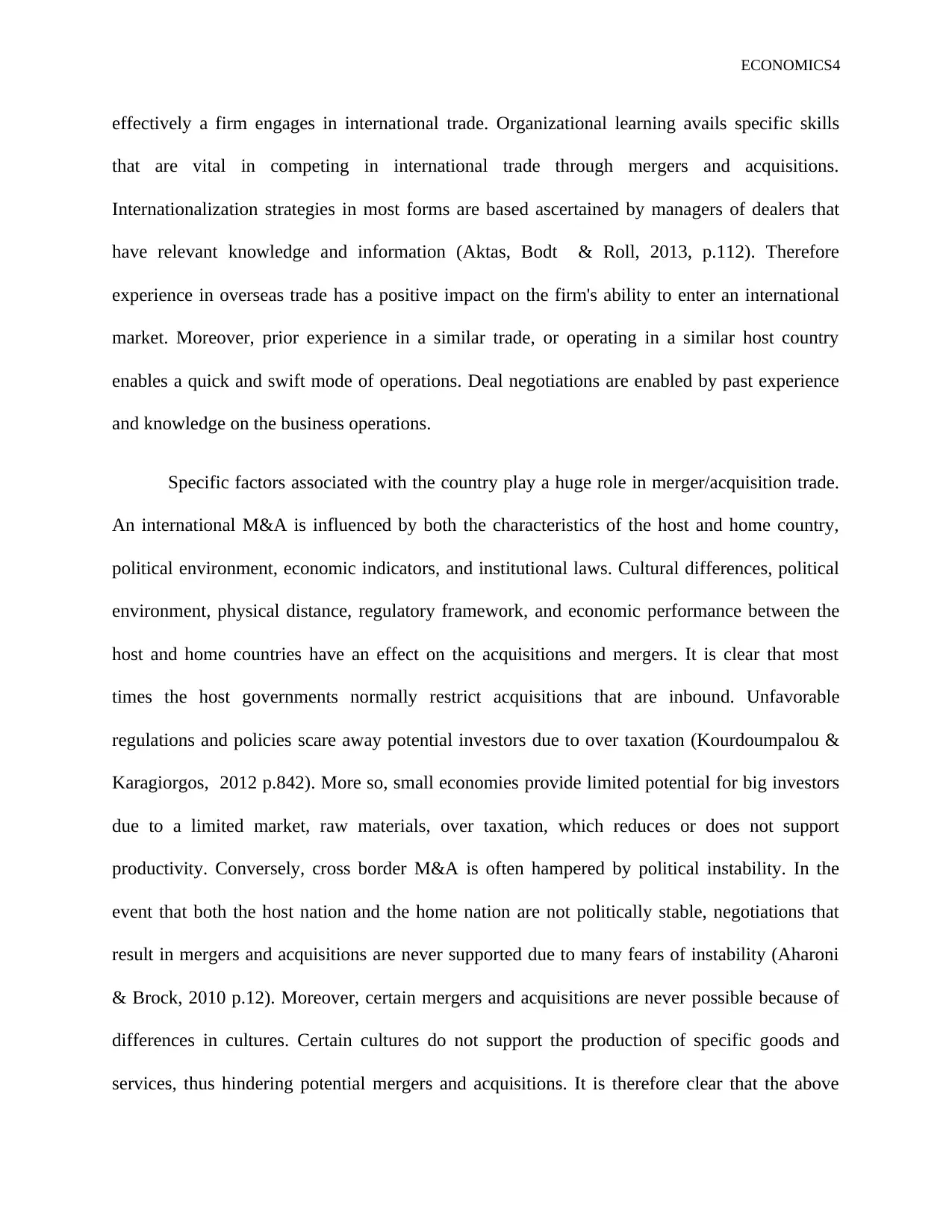
ECONOMICS4
effectively a firm engages in international trade. Organizational learning avails specific skills
that are vital in competing in international trade through mergers and acquisitions.
Internationalization strategies in most forms are based ascertained by managers of dealers that
have relevant knowledge and information (Aktas, Bodt & Roll, 2013, p.112). Therefore
experience in overseas trade has a positive impact on the firm's ability to enter an international
market. Moreover, prior experience in a similar trade, or operating in a similar host country
enables a quick and swift mode of operations. Deal negotiations are enabled by past experience
and knowledge on the business operations.
Specific factors associated with the country play a huge role in merger/acquisition trade.
An international M&A is influenced by both the characteristics of the host and home country,
political environment, economic indicators, and institutional laws. Cultural differences, political
environment, physical distance, regulatory framework, and economic performance between the
host and home countries have an effect on the acquisitions and mergers. It is clear that most
times the host governments normally restrict acquisitions that are inbound. Unfavorable
regulations and policies scare away potential investors due to over taxation (Kourdoumpalou &
Karagiorgos, 2012 p.842). More so, small economies provide limited potential for big investors
due to a limited market, raw materials, over taxation, which reduces or does not support
productivity. Conversely, cross border M&A is often hampered by political instability. In the
event that both the host nation and the home nation are not politically stable, negotiations that
result in mergers and acquisitions are never supported due to many fears of instability (Aharoni
& Brock, 2010 p.12). Moreover, certain mergers and acquisitions are never possible because of
differences in cultures. Certain cultures do not support the production of specific goods and
services, thus hindering potential mergers and acquisitions. It is therefore clear that the above
effectively a firm engages in international trade. Organizational learning avails specific skills
that are vital in competing in international trade through mergers and acquisitions.
Internationalization strategies in most forms are based ascertained by managers of dealers that
have relevant knowledge and information (Aktas, Bodt & Roll, 2013, p.112). Therefore
experience in overseas trade has a positive impact on the firm's ability to enter an international
market. Moreover, prior experience in a similar trade, or operating in a similar host country
enables a quick and swift mode of operations. Deal negotiations are enabled by past experience
and knowledge on the business operations.
Specific factors associated with the country play a huge role in merger/acquisition trade.
An international M&A is influenced by both the characteristics of the host and home country,
political environment, economic indicators, and institutional laws. Cultural differences, political
environment, physical distance, regulatory framework, and economic performance between the
host and home countries have an effect on the acquisitions and mergers. It is clear that most
times the host governments normally restrict acquisitions that are inbound. Unfavorable
regulations and policies scare away potential investors due to over taxation (Kourdoumpalou &
Karagiorgos, 2012 p.842). More so, small economies provide limited potential for big investors
due to a limited market, raw materials, over taxation, which reduces or does not support
productivity. Conversely, cross border M&A is often hampered by political instability. In the
event that both the host nation and the home nation are not politically stable, negotiations that
result in mergers and acquisitions are never supported due to many fears of instability (Aharoni
& Brock, 2010 p.12). Moreover, certain mergers and acquisitions are never possible because of
differences in cultures. Certain cultures do not support the production of specific goods and
services, thus hindering potential mergers and acquisitions. It is therefore clear that the above
Paraphrase This Document
Need a fresh take? Get an instant paraphrase of this document with our AI Paraphraser
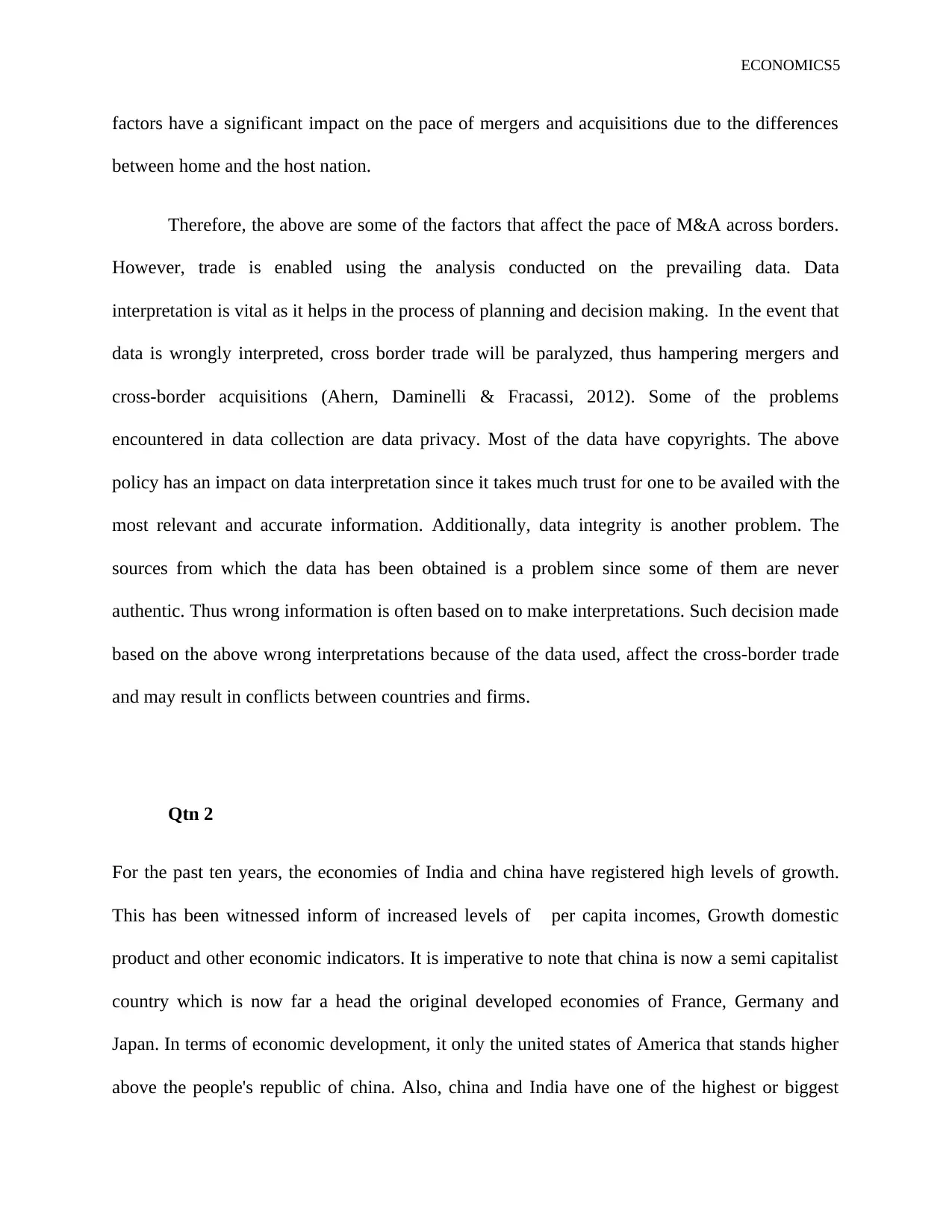
ECONOMICS5
factors have a significant impact on the pace of mergers and acquisitions due to the differences
between home and the host nation.
Therefore, the above are some of the factors that affect the pace of M&A across borders.
However, trade is enabled using the analysis conducted on the prevailing data. Data
interpretation is vital as it helps in the process of planning and decision making. In the event that
data is wrongly interpreted, cross border trade will be paralyzed, thus hampering mergers and
cross-border acquisitions (Ahern, Daminelli & Fracassi, 2012). Some of the problems
encountered in data collection are data privacy. Most of the data have copyrights. The above
policy has an impact on data interpretation since it takes much trust for one to be availed with the
most relevant and accurate information. Additionally, data integrity is another problem. The
sources from which the data has been obtained is a problem since some of them are never
authentic. Thus wrong information is often based on to make interpretations. Such decision made
based on the above wrong interpretations because of the data used, affect the cross-border trade
and may result in conflicts between countries and firms.
Qtn 2
For the past ten years, the economies of India and china have registered high levels of growth.
This has been witnessed inform of increased levels of per capita incomes, Growth domestic
product and other economic indicators. It is imperative to note that china is now a semi capitalist
country which is now far a head the original developed economies of France, Germany and
Japan. In terms of economic development, it only the united states of America that stands higher
above the people's republic of china. Also, china and India have one of the highest or biggest
factors have a significant impact on the pace of mergers and acquisitions due to the differences
between home and the host nation.
Therefore, the above are some of the factors that affect the pace of M&A across borders.
However, trade is enabled using the analysis conducted on the prevailing data. Data
interpretation is vital as it helps in the process of planning and decision making. In the event that
data is wrongly interpreted, cross border trade will be paralyzed, thus hampering mergers and
cross-border acquisitions (Ahern, Daminelli & Fracassi, 2012). Some of the problems
encountered in data collection are data privacy. Most of the data have copyrights. The above
policy has an impact on data interpretation since it takes much trust for one to be availed with the
most relevant and accurate information. Additionally, data integrity is another problem. The
sources from which the data has been obtained is a problem since some of them are never
authentic. Thus wrong information is often based on to make interpretations. Such decision made
based on the above wrong interpretations because of the data used, affect the cross-border trade
and may result in conflicts between countries and firms.
Qtn 2
For the past ten years, the economies of India and china have registered high levels of growth.
This has been witnessed inform of increased levels of per capita incomes, Growth domestic
product and other economic indicators. It is imperative to note that china is now a semi capitalist
country which is now far a head the original developed economies of France, Germany and
Japan. In terms of economic development, it only the united states of America that stands higher
above the people's republic of china. Also, china and India have one of the highest or biggest

ECONOMICS6
populations throughout the Globe (Rodriguez 2011). The population of India just accounts for
1/3 of the total Chinese population. Therefore basing on the above background, this paper will
provide a comprehensive analysis of the differences and seminaries of the economies of India
and china. The comparison will be centered on the Growth domestic product of the two countries
(GDP), growth national product (GNP), health sector and educational status. Also, the problems
affecting the two economies will be highlighted to ascertain the overall level of economic growth
and development of the two countries (Rodriguez 2011).
Seismic shits or changes in the global economy have been evidenced in the past thirty years
(Rodriguez 2011) the main rationale for these shifts has been mainly due to failed economic,
political and social policies in china and India, backwardness and poverty (Wu 2008). China and
India are being regarded as strong and at the same time very important economies in the world of
recent. The two economies of china and India significantly differ in terms of gross prospects this
is mainly as a result of the different internal constraints and challenges that affect each of the two
countries (Sen 2011). There have slowing down of the Chinese economy over the medium and a
robust growth of the Indian economy. The investment plans in china are being supported by a
strong emphasis in infrastructural development (Verick 2014). However, in the short run it has
been unsustainable. Excess capacity challenges in china have resulted into manufacturing sector
led growth. In regards to the Indian economy, increased investment rates have been witnessed
mainly emanating from a strong and favorable business environment, private investments and
partnerships and lastly public infrastructural development. However, the above process has not
been effectively accelerated due to the absence of structural reforms according to studies carried
out ((Pavthran & Mukthar 2011)). Increase or rises in private levels of consumption have been
witnessed India mainly due to high salaries and other fringe benefits prevalent in the Indian
populations throughout the Globe (Rodriguez 2011). The population of India just accounts for
1/3 of the total Chinese population. Therefore basing on the above background, this paper will
provide a comprehensive analysis of the differences and seminaries of the economies of India
and china. The comparison will be centered on the Growth domestic product of the two countries
(GDP), growth national product (GNP), health sector and educational status. Also, the problems
affecting the two economies will be highlighted to ascertain the overall level of economic growth
and development of the two countries (Rodriguez 2011).
Seismic shits or changes in the global economy have been evidenced in the past thirty years
(Rodriguez 2011) the main rationale for these shifts has been mainly due to failed economic,
political and social policies in china and India, backwardness and poverty (Wu 2008). China and
India are being regarded as strong and at the same time very important economies in the world of
recent. The two economies of china and India significantly differ in terms of gross prospects this
is mainly as a result of the different internal constraints and challenges that affect each of the two
countries (Sen 2011). There have slowing down of the Chinese economy over the medium and a
robust growth of the Indian economy. The investment plans in china are being supported by a
strong emphasis in infrastructural development (Verick 2014). However, in the short run it has
been unsustainable. Excess capacity challenges in china have resulted into manufacturing sector
led growth. In regards to the Indian economy, increased investment rates have been witnessed
mainly emanating from a strong and favorable business environment, private investments and
partnerships and lastly public infrastructural development. However, the above process has not
been effectively accelerated due to the absence of structural reforms according to studies carried
out ((Pavthran & Mukthar 2011)). Increase or rises in private levels of consumption have been
witnessed India mainly due to high salaries and other fringe benefits prevalent in the Indian
⊘ This is a preview!⊘
Do you want full access?
Subscribe today to unlock all pages.

Trusted by 1+ million students worldwide
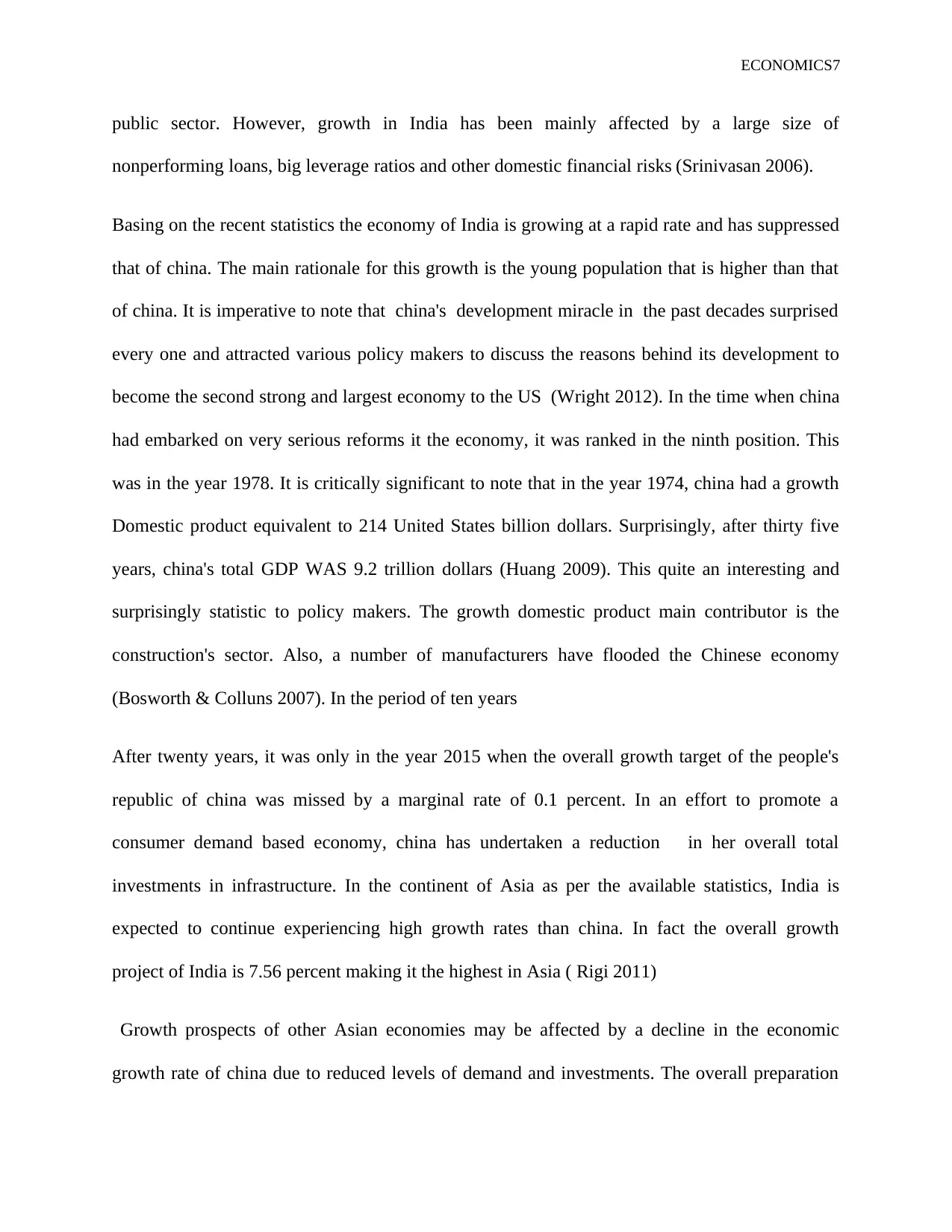
ECONOMICS7
public sector. However, growth in India has been mainly affected by a large size of
nonperforming loans, big leverage ratios and other domestic financial risks (Srinivasan 2006).
Basing on the recent statistics the economy of India is growing at a rapid rate and has suppressed
that of china. The main rationale for this growth is the young population that is higher than that
of china. It is imperative to note that china's development miracle in the past decades surprised
every one and attracted various policy makers to discuss the reasons behind its development to
become the second strong and largest economy to the US (Wright 2012). In the time when china
had embarked on very serious reforms it the economy, it was ranked in the ninth position. This
was in the year 1978. It is critically significant to note that in the year 1974, china had a growth
Domestic product equivalent to 214 United States billion dollars. Surprisingly, after thirty five
years, china's total GDP WAS 9.2 trillion dollars (Huang 2009). This quite an interesting and
surprisingly statistic to policy makers. The growth domestic product main contributor is the
construction's sector. Also, a number of manufacturers have flooded the Chinese economy
(Bosworth & Colluns 2007). In the period of ten years
After twenty years, it was only in the year 2015 when the overall growth target of the people's
republic of china was missed by a marginal rate of 0.1 percent. In an effort to promote a
consumer demand based economy, china has undertaken a reduction in her overall total
investments in infrastructure. In the continent of Asia as per the available statistics, India is
expected to continue experiencing high growth rates than china. In fact the overall growth
project of India is 7.56 percent making it the highest in Asia ( Rigi 2011)
Growth prospects of other Asian economies may be affected by a decline in the economic
growth rate of china due to reduced levels of demand and investments. The overall preparation
public sector. However, growth in India has been mainly affected by a large size of
nonperforming loans, big leverage ratios and other domestic financial risks (Srinivasan 2006).
Basing on the recent statistics the economy of India is growing at a rapid rate and has suppressed
that of china. The main rationale for this growth is the young population that is higher than that
of china. It is imperative to note that china's development miracle in the past decades surprised
every one and attracted various policy makers to discuss the reasons behind its development to
become the second strong and largest economy to the US (Wright 2012). In the time when china
had embarked on very serious reforms it the economy, it was ranked in the ninth position. This
was in the year 1978. It is critically significant to note that in the year 1974, china had a growth
Domestic product equivalent to 214 United States billion dollars. Surprisingly, after thirty five
years, china's total GDP WAS 9.2 trillion dollars (Huang 2009). This quite an interesting and
surprisingly statistic to policy makers. The growth domestic product main contributor is the
construction's sector. Also, a number of manufacturers have flooded the Chinese economy
(Bosworth & Colluns 2007). In the period of ten years
After twenty years, it was only in the year 2015 when the overall growth target of the people's
republic of china was missed by a marginal rate of 0.1 percent. In an effort to promote a
consumer demand based economy, china has undertaken a reduction in her overall total
investments in infrastructure. In the continent of Asia as per the available statistics, India is
expected to continue experiencing high growth rates than china. In fact the overall growth
project of India is 7.56 percent making it the highest in Asia ( Rigi 2011)
Growth prospects of other Asian economies may be affected by a decline in the economic
growth rate of china due to reduced levels of demand and investments. The overall preparation
Paraphrase This Document
Need a fresh take? Get an instant paraphrase of this document with our AI Paraphraser
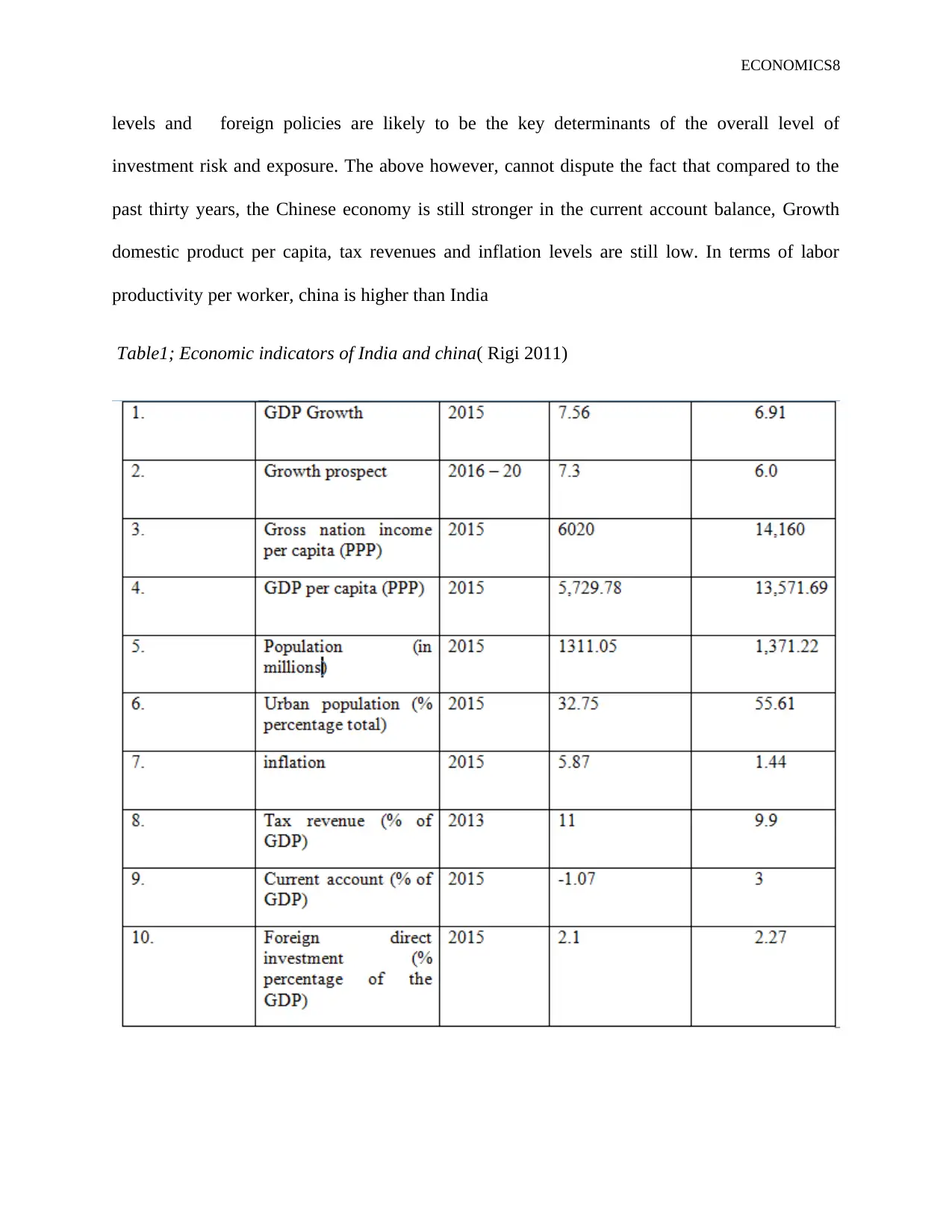
ECONOMICS8
levels and foreign policies are likely to be the key determinants of the overall level of
investment risk and exposure. The above however, cannot dispute the fact that compared to the
past thirty years, the Chinese economy is still stronger in the current account balance, Growth
domestic product per capita, tax revenues and inflation levels are still low. In terms of labor
productivity per worker, china is higher than India
Table1; Economic indicators of India and china( Rigi 2011)
levels and foreign policies are likely to be the key determinants of the overall level of
investment risk and exposure. The above however, cannot dispute the fact that compared to the
past thirty years, the Chinese economy is still stronger in the current account balance, Growth
domestic product per capita, tax revenues and inflation levels are still low. In terms of labor
productivity per worker, china is higher than India
Table1; Economic indicators of India and china( Rigi 2011)

ECONOMICS9
India has relatively lower productivity levels when compared to china that have a booming
manufacturing sector. The overall Indian manufacturing sector needs to be fixed given that it is
characterized with inadequate infrastructure, technology and skilled workforce. India's
challenges apart from manufacturing are still many. India has high levels of corruption in its
sectors; there is also lack of credit access to the rural poor in India, domestic violence, high
levels of inequality and other forms of discrimination. The poor Indian health care system and
high illiteracy levels coupled with high corruption levels makes India less developed when
compared to china. Therefore India needs to adequate put across mechanisms that will help in
ensuring that corruption and embezzlement is eliminated in its sector. This can be achieved
through imposing harsh penalties on the corrupt. The economy of china has achieved most of its
strategic goals due to zero tolerance to corruption, investment in infrastructure, manufacturing
and technology. There is no doubt if the Indian institutions are strengthened and more
investments made in infrastructure, manufacturing and health, India will be among the top
economies in the world.
India has relatively lower productivity levels when compared to china that have a booming
manufacturing sector. The overall Indian manufacturing sector needs to be fixed given that it is
characterized with inadequate infrastructure, technology and skilled workforce. India's
challenges apart from manufacturing are still many. India has high levels of corruption in its
sectors; there is also lack of credit access to the rural poor in India, domestic violence, high
levels of inequality and other forms of discrimination. The poor Indian health care system and
high illiteracy levels coupled with high corruption levels makes India less developed when
compared to china. Therefore India needs to adequate put across mechanisms that will help in
ensuring that corruption and embezzlement is eliminated in its sector. This can be achieved
through imposing harsh penalties on the corrupt. The economy of china has achieved most of its
strategic goals due to zero tolerance to corruption, investment in infrastructure, manufacturing
and technology. There is no doubt if the Indian institutions are strengthened and more
investments made in infrastructure, manufacturing and health, India will be among the top
economies in the world.
⊘ This is a preview!⊘
Do you want full access?
Subscribe today to unlock all pages.

Trusted by 1+ million students worldwide
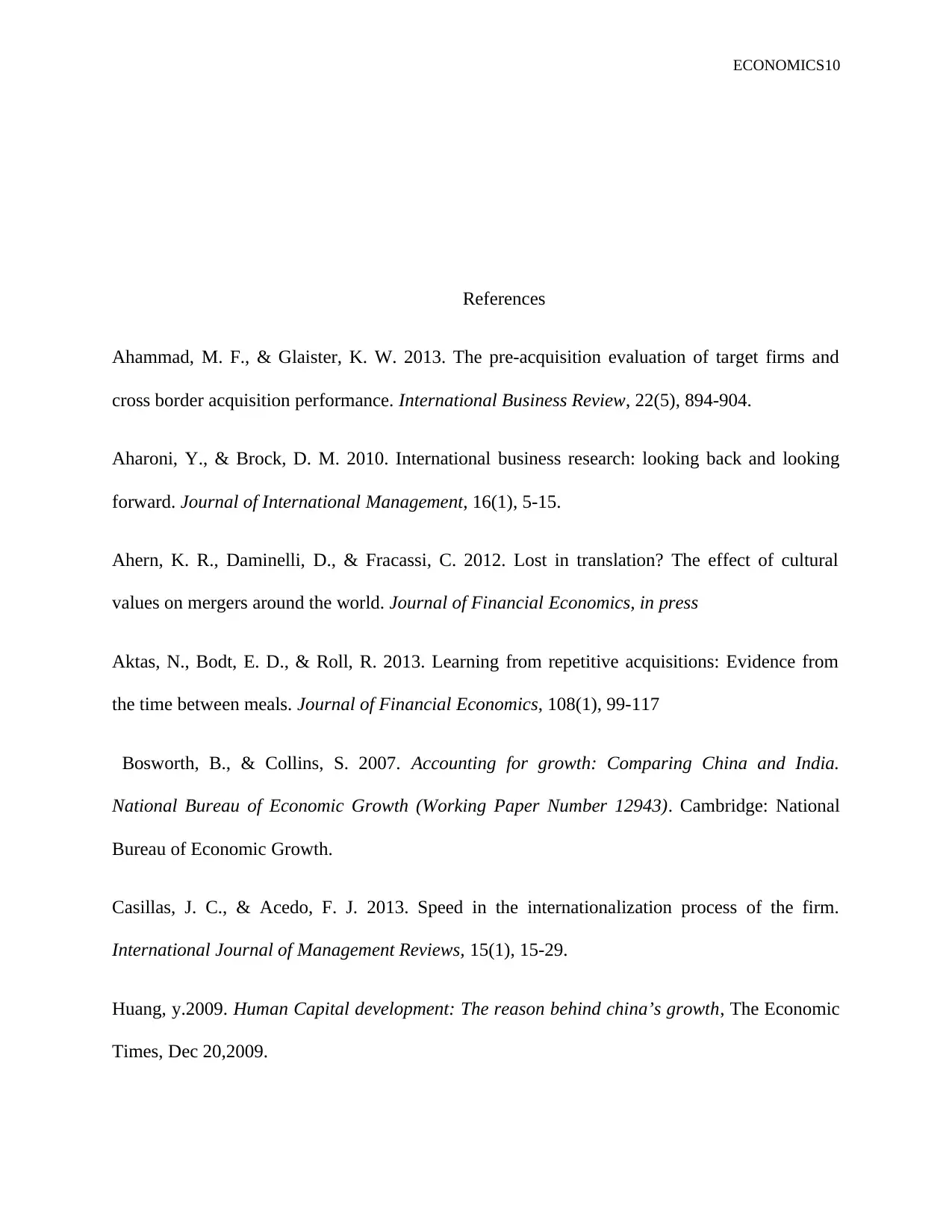
ECONOMICS10
References
Ahammad, M. F., & Glaister, K. W. 2013. The pre-acquisition evaluation of target firms and
cross border acquisition performance. International Business Review, 22(5), 894-904.
Aharoni, Y., & Brock, D. M. 2010. International business research: looking back and looking
forward. Journal of International Management, 16(1), 5-15.
Ahern, K. R., Daminelli, D., & Fracassi, C. 2012. Lost in translation? The effect of cultural
values on mergers around the world. Journal of Financial Economics, in press
Aktas, N., Bodt, E. D., & Roll, R. 2013. Learning from repetitive acquisitions: Evidence from
the time between meals. Journal of Financial Economics, 108(1), 99-117
Bosworth, B., & Collins, S. 2007. Accounting for growth: Comparing China and India.
National Bureau of Economic Growth (Working Paper Number 12943). Cambridge: National
Bureau of Economic Growth.
Casillas, J. C., & Acedo, F. J. 2013. Speed in the internationalization process of the firm.
International Journal of Management Reviews, 15(1), 15-29.
Huang, y.2009. Human Capital development: The reason behind china’s growth, The Economic
Times, Dec 20,2009.
References
Ahammad, M. F., & Glaister, K. W. 2013. The pre-acquisition evaluation of target firms and
cross border acquisition performance. International Business Review, 22(5), 894-904.
Aharoni, Y., & Brock, D. M. 2010. International business research: looking back and looking
forward. Journal of International Management, 16(1), 5-15.
Ahern, K. R., Daminelli, D., & Fracassi, C. 2012. Lost in translation? The effect of cultural
values on mergers around the world. Journal of Financial Economics, in press
Aktas, N., Bodt, E. D., & Roll, R. 2013. Learning from repetitive acquisitions: Evidence from
the time between meals. Journal of Financial Economics, 108(1), 99-117
Bosworth, B., & Collins, S. 2007. Accounting for growth: Comparing China and India.
National Bureau of Economic Growth (Working Paper Number 12943). Cambridge: National
Bureau of Economic Growth.
Casillas, J. C., & Acedo, F. J. 2013. Speed in the internationalization process of the firm.
International Journal of Management Reviews, 15(1), 15-29.
Huang, y.2009. Human Capital development: The reason behind china’s growth, The Economic
Times, Dec 20,2009.
Paraphrase This Document
Need a fresh take? Get an instant paraphrase of this document with our AI Paraphraser
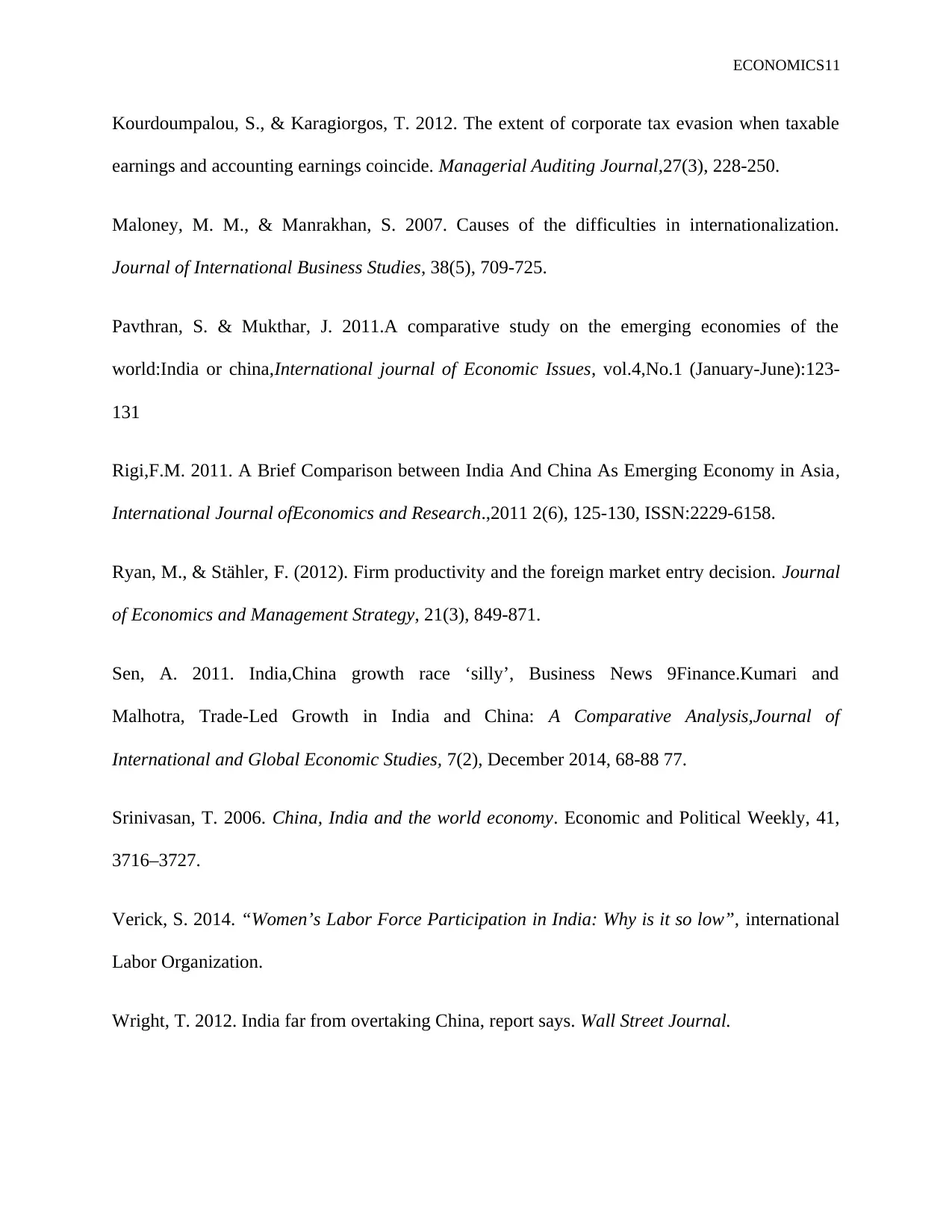
ECONOMICS11
Kourdoumpalou, S., & Karagiorgos, T. 2012. The extent of corporate tax evasion when taxable
earnings and accounting earnings coincide. Managerial Auditing Journal,27(3), 228-250.
Maloney, M. M., & Manrakhan, S. 2007. Causes of the difficulties in internationalization.
Journal of International Business Studies, 38(5), 709-725.
Pavthran, S. & Mukthar, J. 2011.A comparative study on the emerging economies of the
world:India or china,International journal of Economic Issues, vol.4,No.1 (January-June):123-
131
Rigi,F.M. 2011. A Brief Comparison between India And China As Emerging Economy in Asia,
International Journal ofEconomics and Research.,2011 2(6), 125-130, ISSN:2229-6158.
Ryan, M., & Stähler, F. (2012). Firm productivity and the foreign market entry decision. Journal
of Economics and Management Strategy, 21(3), 849-871.
Sen, A. 2011. India,China growth race ‘silly’, Business News 9Finance.Kumari and
Malhotra, Trade-Led Growth in India and China: A Comparative Analysis,Journal of
International and Global Economic Studies, 7(2), December 2014, 68-88 77.
Srinivasan, T. 2006. China, India and the world economy. Economic and Political Weekly, 41,
3716–3727.
Verick, S. 2014. “Women’s Labor Force Participation in India: Why is it so low”, international
Labor Organization.
Wright, T. 2012. India far from overtaking China, report says. Wall Street Journal.
Kourdoumpalou, S., & Karagiorgos, T. 2012. The extent of corporate tax evasion when taxable
earnings and accounting earnings coincide. Managerial Auditing Journal,27(3), 228-250.
Maloney, M. M., & Manrakhan, S. 2007. Causes of the difficulties in internationalization.
Journal of International Business Studies, 38(5), 709-725.
Pavthran, S. & Mukthar, J. 2011.A comparative study on the emerging economies of the
world:India or china,International journal of Economic Issues, vol.4,No.1 (January-June):123-
131
Rigi,F.M. 2011. A Brief Comparison between India And China As Emerging Economy in Asia,
International Journal ofEconomics and Research.,2011 2(6), 125-130, ISSN:2229-6158.
Ryan, M., & Stähler, F. (2012). Firm productivity and the foreign market entry decision. Journal
of Economics and Management Strategy, 21(3), 849-871.
Sen, A. 2011. India,China growth race ‘silly’, Business News 9Finance.Kumari and
Malhotra, Trade-Led Growth in India and China: A Comparative Analysis,Journal of
International and Global Economic Studies, 7(2), December 2014, 68-88 77.
Srinivasan, T. 2006. China, India and the world economy. Economic and Political Weekly, 41,
3716–3727.
Verick, S. 2014. “Women’s Labor Force Participation in India: Why is it so low”, international
Labor Organization.
Wright, T. 2012. India far from overtaking China, report says. Wall Street Journal.
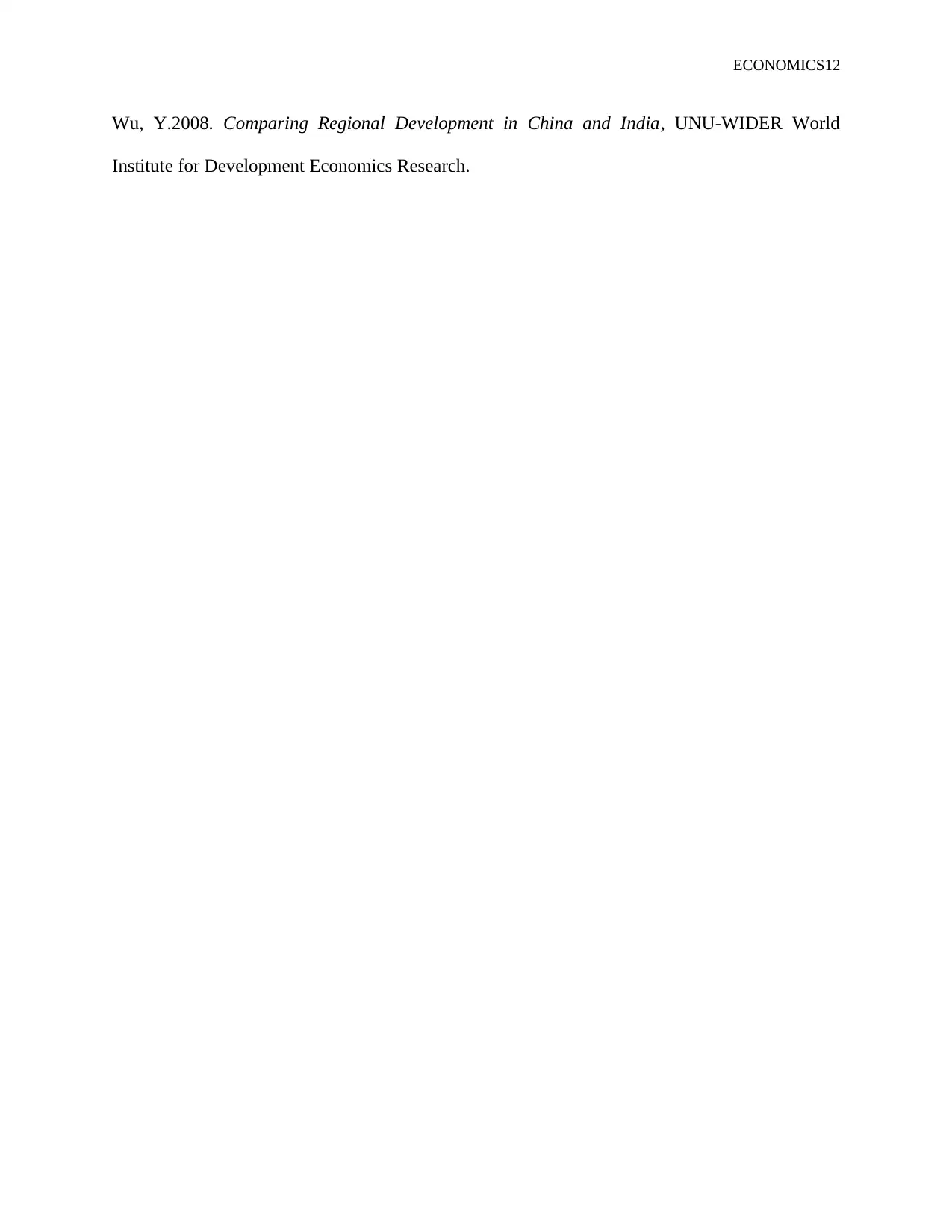
ECONOMICS12
Wu, Y.2008. Comparing Regional Development in China and India, UNU-WIDER World
Institute for Development Economics Research.
Wu, Y.2008. Comparing Regional Development in China and India, UNU-WIDER World
Institute for Development Economics Research.
⊘ This is a preview!⊘
Do you want full access?
Subscribe today to unlock all pages.

Trusted by 1+ million students worldwide
1 out of 12
Your All-in-One AI-Powered Toolkit for Academic Success.
+13062052269
info@desklib.com
Available 24*7 on WhatsApp / Email
![[object Object]](/_next/static/media/star-bottom.7253800d.svg)
Unlock your academic potential
Copyright © 2020–2025 A2Z Services. All Rights Reserved. Developed and managed by ZUCOL.